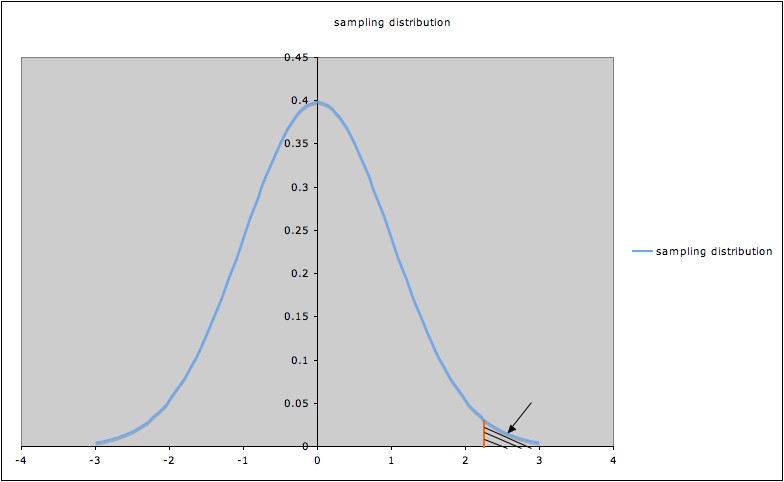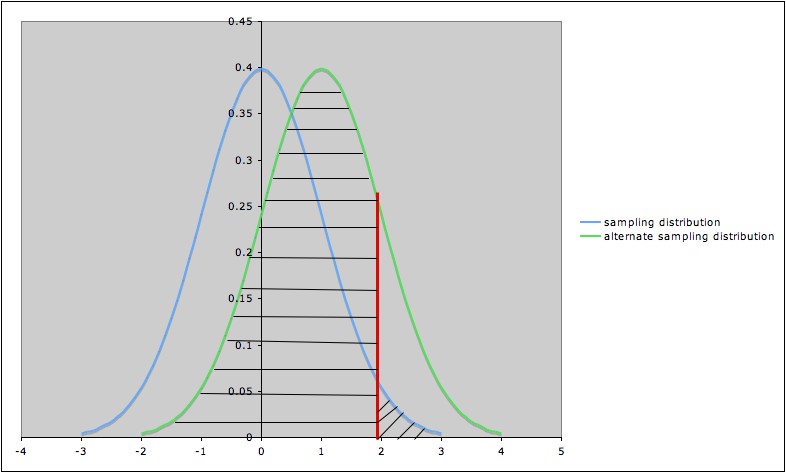COMMON MISTEAKS
MISTAKES IN
USING STATISTICS: Spotting and Avoiding Them
Type I and II Errors and Significance Levels
Type
I Error
Rejecting the null
hypothesis when it is in fact true is called
a Type I error.
Many people decide, before doing a hypothesis test, on a maximum
p-value for which they will reject the null hypothesis. This value is
often denoted α (alpha) and is also called the significance
level.
When a hypothesis
test results in a p-value that is less than the significance level, the
result of the hypothesis test is called
statistically significant.
Common
mistake: Confusing statistical significance
and
practical significance.
Example:
A
large clinical trial is carried out to compare a new medical treatment
with a
standard one. The statistical analysis shows a statistically
significant difference in lifespan when using the new treatment
compared to the old one. But the increase in lifespan is at most three
days, with average increase less than 24 hours, and with poor quality
of
life during the period of extended life. Most people would not consider
the improvement practically significant.
Caution:
The larger the sample
size, the more likely a
hypothesis test will detect a small difference. Thus it is especially
important to consider
practical
significance when sample size is large.
Connection between
Type I error and significance level:
A significance
level
α
corresponds to a certain value of the test statistic, say tα,
represented by the orange line in the picture
of a sampling distribution below (the picture illustrates a hypothesis
test with alternate hypothesis
"µ
> 0")
Since the shaded
area
indicated by the arrow is the p-value corresponding to tα,
that p-value (shaded area) is α.
To have p-value less than α
, a t-value for this test must be to the right of tα.
So the probability of rejecting the null
hypothesis when it is true is
the probability that t > tα,
which we saw above is α.
In other words, the
probability of Type I error is α.1
Rephrasing using the
definition of Type I error:
The
significance level α is
the probability of making the wrong decision when the null hypothesis is true.
Pros and Cons of
Setting a Significance Level:
- Setting a significance level (before
doing inference) has the advantage
that the analyst is
not tempted to chose a cut-off on the basis of what he or she hopes is
true.
- It has the disadvantage
that it neglects that some p-values might
best be considered borderline. This
is one reason2 why it is important to report p-values when
reporting
results of hypothesis tests. It is also good practice to include
confidence
intervals corresponding to the hypothesis test. (For
example, if a hypothesis test for the difference of two means is
performed, also give a confidence interval for the difference of those
means. If the significance level for the hypothesis test is .05, then
use confidence level 95% for the confidence interval.)
Type
II Error
Not rejecting the null hypothesis when in fact the alternate
hypothesis is true is called a Type
II error. (The second example below provides a situation
where
the concept of Type II error is important.)
Note: "The alternate
hypothesis" in the definition of Type II error may refer to the
alternate hypothesis in a hypothesis test, or it may refer to a
"specific" alternate hypothesis.
Example:
In a t-test for a sample
mean µ, with null hypothesis ""µ
= 0" and alternate
hypothesis "µ
> 0", we may talk about the Type II error relative to the
general alternate hypothesis "µ
> 0", or may talk about the Type II error relative to the specific
alternate hypothesis "µ
> 1". Note that the specific alternate hypothesis is a
special case
of the general alternate hypothesis.
In practice, people often work with Type II error
relative to a specific
alternate hypothesis. In this situation, the
probability of Type II error relative to the specific alternate
hypothesis is often called β. In other words, β
is the probability of
making the wrong decision when the specific
alternate hypothesis is true.
(See the discussion
of
Power for related detail.)
Considering both
types of error together:
The following table summarizes Type I and Type II errors:
|
Truth
(for population studied) |
| Null Hypothesis True |
Null Hypothesis False |
Decision
(based on sample) |
Reject Null Hypothesis |
Type
I Error |
Correct
Decision |
| Fail to reject Null Hypothesis |
Correct
Decision |
Type II
Error |
An analogy3 that some people find
helpful (but others don't) in
understanding the two types of error is to consider a defendant in a
trial. The null hypothesis is "defendant is not guilty;" the alternate
is "defendant is guilty."4 A Type I error would correspond
to convicting an innocent person; a Type II error would correspond to
setting a guilty person free. The analogous table would be:
|
Truth |
| Not Guilty |
Guilty |
| Verdict |
Guilty |
Type I Error -- Innocent person goes to
jail (and
maybe guilty person goes free) |
Correct Decision |
| Not Guilty |
Correct Decision |
Type II Error -- Guilty person goes free |
The following diagram illustrates the Type I error and the
Type II error against the specific alternate hypothesis "µ
=1" in a hypothesis test for a
population
mean µ, with null hypothesis ""µ
= 0," alternate
hypothesis "µ
> 0", and significance level α=
0.05.
- The blue (leftmost) curve is
the sampling
distribution
assuming the null hypothesis ""µ
= 0."
- The green (rightmost) curve is
the sampling
distribution assuming the specific alternate hypothesis "µ
=1".
- The vertical red line shows the
cut-off for
rejection of the null hypothesis: the null hypothesis is rejected for
values of the test statistic to the right
of the red line (and not
rejected for values to the left
of the red line)>
- The area of the diagonally
hatched region
to the right of the red line
and under the blue curve is
the
probability of type I error (α)
- The area of the horizontally hatched
region to
the left of the red line and
under the green curve is the
probability
of Type II error (β)
Deciding
what significance level to use:
This should be done before
analyzing the data -- preferably before gathering the data.5
The choice of significance level should be based on the consequences
of Type I and Type II errors.
- If the consequences of a type I error are
serious or
expensive, then
a very small significance level is appropriate.
Example
1:
Two drugs are being compared for effectiveness in treating
the same condition. Drug 1 is very affordable,
but Drug 2 is extremely expensive. The
null hypothesis is "both drugs are equally effective," and the
alternate is "Drug 2 is more effective than Drug 1." In this situation,
a Type I error
would be deciding that Drug 2 is more effective, when in fact it is no
better than Drug 1, but would cost the patient much more money. That
would be undesirable from the patient's perspective, so a
small significance level is warranted.
- If the consequences of a Type I error are
not very
serious (and especially if a Type II error has serious consequences),
then a
larger significance level is appropriate.
Example
2:
Two drugs are known to be equally effective for a certain
condition. They are also each equally affordable. However, there is
some suspicion that Drug 2 causes a serious side-effect in some
patients, whereas Drug 1 has been used for decades with no reports of
the side effect. The null hypothesis is "the incidence of the side
effect in both drugs is the same", and the alternate is "the incidence
of the side effect in Drug 2 is greater than that in Drug 1." Falsely
rejecting the null hypothesis when it is in fact true (Type I error)
would have no great
consequences for the consumer, but a Type II error (i.e., failing to
reject the null
hypothesis
when in fact the alternate is true, which would result in deciding that
Drug 2 is no
more harmful than Drug 1 when it is in fact more harmful) could have
serious consequences from
a public health standpoint. So setting a large significance level is
appropriate.
See Sample
size calculations to plan an experiment, GraphPad.com, for more
examples.
Common
mistake: Neglecting to
think adequately about possible
consequences of Type I and Type II errors (and deciding acceptable
levels of Type I and II errors based on these consequences)
before conducting a study and analyzing
data.
- Sometimes there may be serious consequences
of each
alternative, so some compromises or weighing priorities may be
necessary. The trial analogy illustrates this well: Which is better or
worse, imprisoning an innocent person or letting a guilty person go
free?6 This is a value
judgment; value judgments are often involved in deciding on
significance levels. Trying to avoid the issue by always choosing the
same
significance level is itself a value judgment.
- Sometimes different stakeholders have
different
interests that compete (e.g., in the second example above, the
developers of Drug 2 might prefer to have a smaller significance level.)
- See http://core.ecu.edu/psyc/wuenschk/StatHelp/Type-I-II-Errors.htm
for more discussion of the considerations involved in deciding what are
reasonable levels for Type I and Type II errors.
- See the discussion of Power
for more on deciding on a significance level.
- Similar considerations hold for setting confidence levels for confidence intervals.
Common
mistake: Claiming that an
alternate hypothesis has been "proved" because it has been rejected in
a hypothesis test.
- This is an instance of the common mistake
of expecting too much certainty.
- There is always a possibility of a Type I error; the
sample in the study might have been one of the small percentage of
samples giving an unusually extreme test statistic.
- This is why replicating
experiments (i.e., repeating the experiment with another
sample) is important. The more experiments that give the same result,
the stronger the evidence.
- There is also the possibility that the
sample is biased or the method of analysis was inappropriate;
either of these could lead to a misleading result.
1. α
is also called the bound
on Type I error. Choosing a value α
is sometimes called setting a bound
on Type I error.
2. Another good reason for reporting p-values is that different
people may have different standards of evidence; see the section "Deciding
what significance level to use" on
this page.
3. This could be more than just an analogy: Consider a situation
where the verdict hinges on statistical evidence (e.g., a DNA test),
and where rejecting the null hypothesis would result in a verdict of
guilty, and not rejecting the null hypothesis would result in a verdict
of not guilty.
4. This is consistent with the system of justice in the USA, in which a
defendant is assumed innocent until proven guilty beyond a reasonable
doubt; proving the defendant guilty beyond a reasonable doubt is
analogous to providing evidence that would be very unusual if the null
hypothesis is true.
5. There are (at least) two reasons why this is important. First,
the significance level desired is one criterion in deciding on an
appropriate sample size. (See Power for
more information.)
Second, if more than one hypothesis test is planned, additional
considerations need to be taken into account. (See Multiple Inference for more
information.)
6. The answer to this may well depend on the seriousness of the
punishment and the seriousness of the crime. For example, if the
punishment is death, a Type I error is extremely serious. Also, if a
Type I error results in a criminal going free as well as an innocent
person being punished, then it is more serious than a Type II error.
Last updated May 12, 2011


